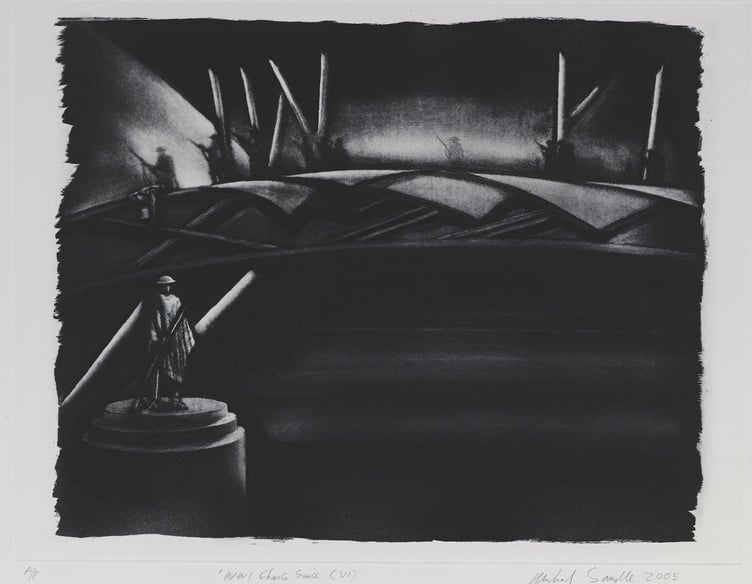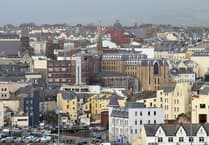Highly regarded international sculptor Michael Sandle has brought his talents to the Isle of Man with four new pieces of his work being submitted to the Manx Aviation and Military Museum.
The works, which look to commemorate fallen soldiers during World War One, were officially placed inside the museum on Friday, November 17.
Sandle’s main piece of work, which is titled ‘World War One Ghosts’, powerfully reflect the tragic and needless loss of young lives in war while honouring those that were lost.
The concept of ‘Pals Regiments’ are also reflected in Mr Sandle’s submitted work. This concept was the idea that British forces let friends who volunteered together fight in the same units to encourage recruitment and service.
Sandle had in mind a group of pals from a district of the Yorkshire city of Leeds, who were all killed on the infamous first day of the Battle of the Somme on July 1, 1916.
The artist memorialises the fallen in numerous ways and World War One Ghosts shows a soldier in the last split-second of life as a bomb blasts.
In another piece of his work, soldiers under fire cross a damaged metal bridge, while soldiers in a third piece appear larger with the leading man having been shot and the dramatic diagonals of the bridge gleaming in the surrounding darkness.
The soldiers are even more ghostly in his fourth piece of work, with some barely visible. Splintered trees are also visible in the darkness and a nearby river is blackened.
Talking about his work, Sandle says: ‘One’s identity is inseparable from memory, who we are and whether life is worth living or not. The concept of a nation is based on memory. History is always subject to review. Memory is far more important. If you disrespect death, you disrespect life, and if you disrespect life, then what’s the point of living?’
Sandle uses the artistic technique of ‘etching’ in his work, which blends drawing and sculpture together in the process of using strong acid or mordant to cut into the unprotected parts of a metal surface to create a design.
Describing this process, Sandle says: ‘It’s the most awful and long-winded way of creating an image and it’s incredibly hard work. But in nothing else do you get that richness of texture and those velvety blacks.
‘There’s also a high degree of the unexpected as the effect of the acid on the plate is never totally in one’s control.’
Etching was also used in another piece of Sandle’s work which is based on the Israel Defence Forces - a topical piece due to the ongoing conflict in the Middle East.
This artwork was inspired by an internet news image of the conflict which involves a small boy. Sandle was acutely conscious while he was creating the artwork that the young boy in the image was the same age as his own son.
Born in Weymouth in 1936, Sandle’s family re-located to the Isle of Man during his childhood and he studied at the Douglas School of Art from 1951 to 1954.
He then studied at the Slade School of Fine Art from 1956 to 1959 and worked as a lithographer in Paris in 1960. He lived in Germany for 26 years between 1973 and 1999, becoming Professor of Sculpture at Pforzheim in 1977 and then at Karlsruhe from 1980.
Elected a ‘Royal Academician’ (RA) in 1990, he resigned because of the way the RA handled the Myra Hindley painting controversy during the 1997 ‘Sensation’ exhibition. He was re-elected in 2005 and awarded the first Kenneth Armitage Fellowship (a biannual sculptor award) in 2005.
His most notable commissions include the ‘Malta Siege-Bell Memorial’ at Valletta in 1988, for which he was awarded the ‘Henry Herring Memorial’ by the US National Sculpture Association.
He also sculpted the Seafarers’ Memorial in the year 2000 in London.
His work is represented in numerous public collections in the UK, Isle of Man (Manx National Heritage) and overseas, including the British Museum, the Imperial War Museum, the V&A and Tate in London, the Metropolitan Museum of Art in New York, and in museums in Germany, Poland, Japan and Australia.
On the island, Sandle’s ‘Viking doorway’ sculpture can be seen at the Erin Arts Centre in Port Erin, while his ‘Lifeboatmen’ sculpture is sited in the Marine Gardens in Douglas.
The submission of his works into the Aviation and Military Museum was partly down to help and support from local artist and stamp issue product developer, Paul Ford.
Paul says: ‘I have admired Michael’s work since I saw it at the home of my friend, the late great Douglas artist Reg Quayle, over forty years ago.
‘I got to know Michael through my job as I suggested a set of stamps of his work and I met Ivor Ramsden, director of the Aviation and Military Museum, in a similar way.
‘Seeing Ivor’s fantastic museum I thought it would be great if Michael’s work could be seen there. Michael liked the idea so I asked the Isle of Man Arts Council for help with the cost of the framing and they kindly agreed.
‘Michael is a great speaker - he could fill an hour on air talking about art, politics, war, life and culture. He has some strong views developed from a lifetime of experience and is great company.’
Talking about adding his artwork to the island museum, Sandle says: ‘I am very pleased to add my etchings to the collection of the excellent Manx Aviation and Military Museum and my thanks go to the Isle of Man Arts Council and Paul Ford for their kind assistance.
‘Much of life is based on circumstance which sometimes means you get lucky.
‘I did because my father, who was in the Royal Navy, was posted to Douglas when I was a child and he could easily have been posted elsewhere.
‘This was sometime around 1943 and my mother, sister and I came over to live in Douglas too.
‘The Isle of Man was spared the Blitz that we had experienced in Plymouth and it turned out to be an idyllic place to grow up in for me, my sister Pam and for my younger brother Douglas who was born on the island and is fiercely proud of that fact.
‘I am proud of the fact that I am considered to be a Manx artist too and also feel extraordinarily fortunate to have been surrounded by the shapes, colours and ever-changing light that is special to this island.’


-(1).jpeg?width=209&height=140&crop=209:145,smart&quality=75)
.png?width=209&height=140&crop=209:145,smart&quality=75)
.jpg?width=209&height=140&crop=209:145,smart&quality=75)